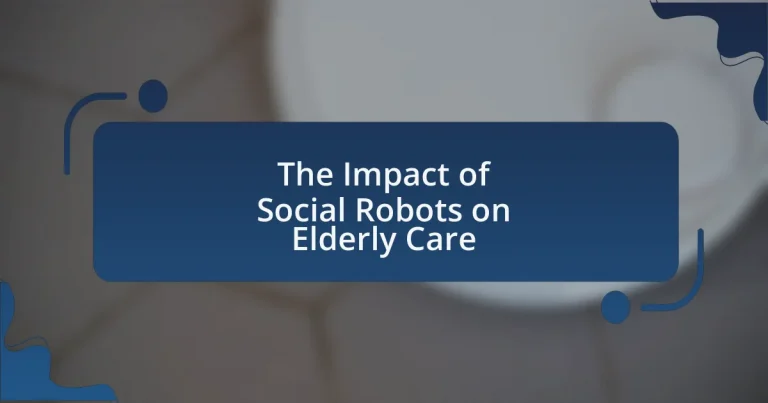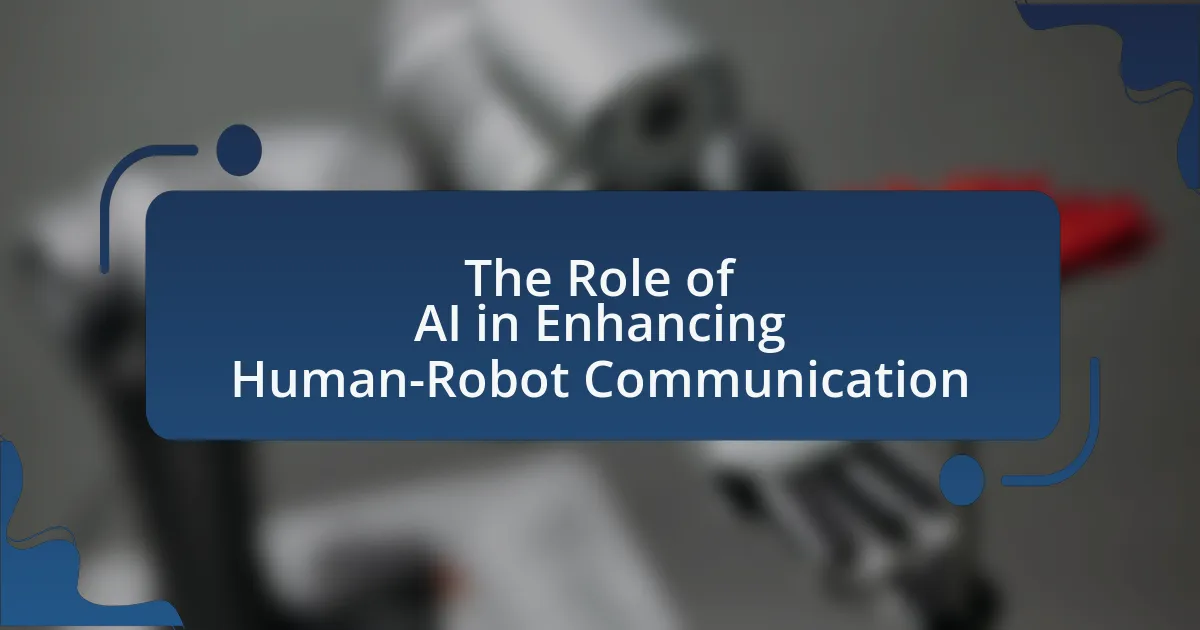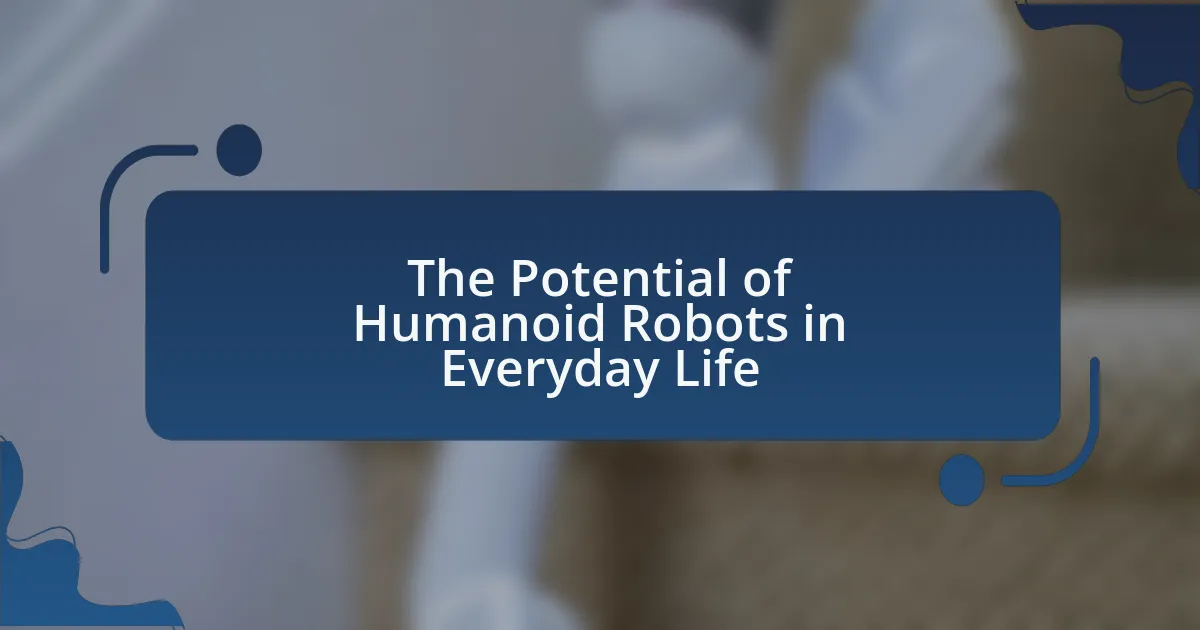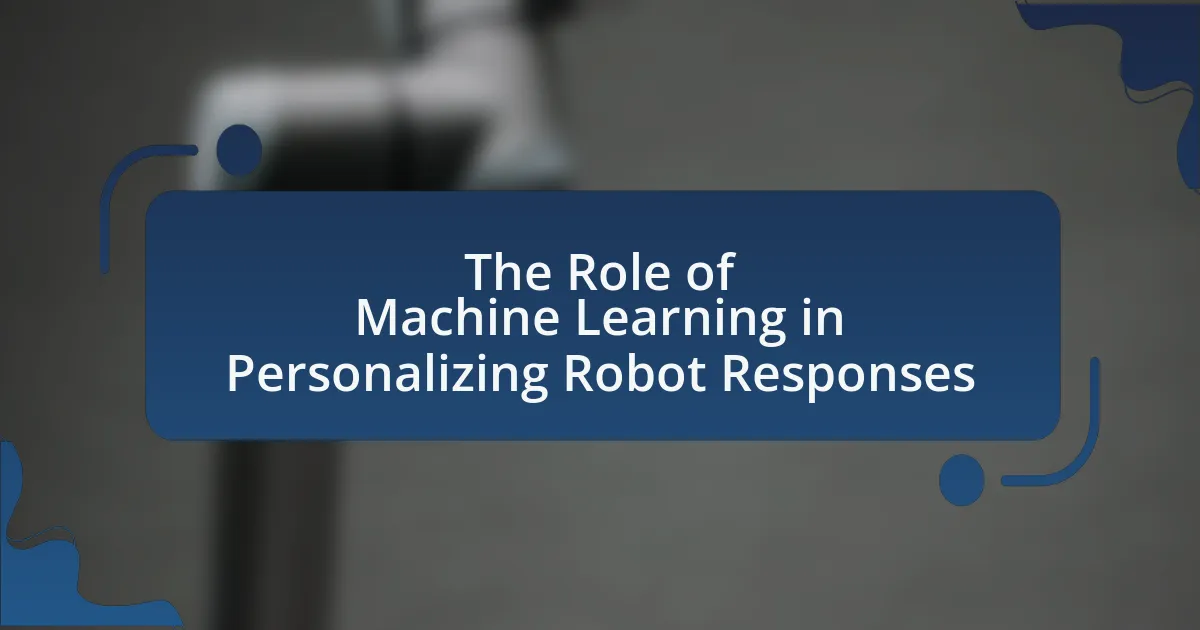Social robots are interactive machines designed to engage with humans, particularly in the context of elderly care, where they provide companionship, assistance, and health monitoring. These robots help alleviate feelings of loneliness and isolation among seniors, which can lead to negative health outcomes. The article explores how social robots function, the technologies that enable their operation, and the various types used in elderly care, such as companion and assistive robots. It also addresses the potential benefits, challenges, and ethical considerations associated with their use, as well as the future of social robots in enhancing the quality of life for elderly individuals.
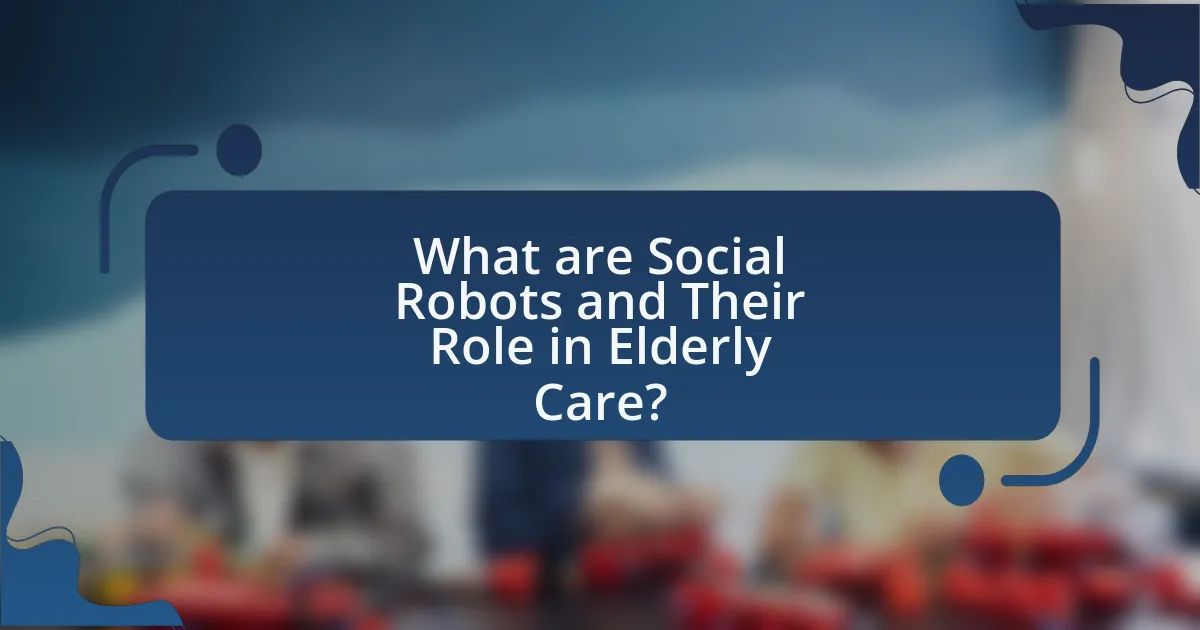
What are Social Robots and Their Role in Elderly Care?
Social robots are interactive machines designed to engage with humans, particularly in social contexts, and they play a significant role in elderly care by providing companionship, assistance, and support. These robots can help reduce feelings of loneliness and isolation among seniors, which is crucial as studies indicate that social isolation can lead to negative health outcomes, including depression and cognitive decline. For instance, research published in the journal “Gerontology” highlights that social robots can improve the emotional well-being of elderly individuals by facilitating social interaction and providing reminders for medication and appointments.
How do social robots function in the context of elderly care?
Social robots function in the context of elderly care by providing companionship, assistance with daily activities, and monitoring health conditions. These robots are designed to engage with elderly individuals through conversation, reminders for medication, and support for mobility, thereby enhancing their quality of life. For instance, studies have shown that social robots can reduce feelings of loneliness and depression among seniors, as evidenced by research published in the journal “Gerontechnology,” which found that interactions with robots improved emotional well-being in elderly participants. Additionally, robots equipped with sensors can track vital signs and alert caregivers in case of emergencies, demonstrating their role in health monitoring.
What technologies enable social robots to assist the elderly?
Social robots assisting the elderly utilize several key technologies, including artificial intelligence, machine learning, natural language processing, and sensor technologies. Artificial intelligence enables robots to understand and respond to human emotions and needs, enhancing interaction quality. Machine learning allows these robots to adapt to individual preferences and behaviors over time, improving their effectiveness in providing personalized care. Natural language processing facilitates communication between the robot and the elderly, making it easier for users to engage with the robot. Sensor technologies, such as cameras and motion detectors, help robots monitor the environment and the health status of elderly individuals, ensuring safety and timely assistance. These technologies collectively enhance the capability of social robots to provide meaningful support and companionship to the elderly.
How do social robots interact with elderly individuals?
Social robots interact with elderly individuals primarily through communication, companionship, and assistance with daily tasks. These robots utilize natural language processing and voice recognition to engage in conversations, providing social interaction that can alleviate feelings of loneliness and isolation among seniors. For instance, studies have shown that robots like PARO, a therapeutic robotic seal, can evoke emotional responses and improve mood in elderly users, demonstrating their effectiveness in enhancing emotional well-being. Additionally, social robots can assist with reminders for medication, appointments, and daily activities, thereby promoting independence and safety. Research indicates that the presence of social robots can lead to increased social engagement and improved quality of life for elderly individuals, as evidenced by a study published in the journal “Gerontechnology,” which found that seniors reported higher satisfaction and reduced anxiety when interacting with social robots.
What types of social robots are used in elderly care?
Social robots used in elderly care include companion robots, assistive robots, and telepresence robots. Companion robots, such as Paro and Aibo, provide emotional support and companionship, helping to reduce feelings of loneliness among seniors. Assistive robots, like Robear and ElliQ, aid in daily tasks such as medication management and mobility assistance, enhancing the independence of elderly individuals. Telepresence robots, such as Double and Beam, facilitate remote communication with family and healthcare providers, ensuring that seniors remain connected to their support networks. These types of robots have been shown to improve the quality of life for elderly individuals by addressing both emotional and practical needs.
What are the most common types of social robots for elderly assistance?
The most common types of social robots for elderly assistance include companion robots, telepresence robots, and service robots. Companion robots, such as Paro and ElliQ, provide emotional support and social interaction, which can alleviate feelings of loneliness among seniors. Telepresence robots, like Double and Beam, enable remote communication with family and healthcare providers, enhancing social connectivity. Service robots, such as Robear and Care-O-bot, assist with daily tasks like medication reminders and mobility support, improving the overall quality of life for elderly individuals. These robots are designed to address specific needs in elderly care, demonstrating their effectiveness in enhancing social interaction and providing practical assistance.
How do different types of social robots cater to various needs of the elderly?
Different types of social robots cater to various needs of the elderly by providing companionship, assistance with daily tasks, and health monitoring. Companion robots, such as Paro and ElliQ, engage seniors in conversation and activities, reducing feelings of loneliness and depression, which are prevalent in this demographic. Assistive robots, like robotic vacuum cleaners and medication dispensers, help elderly individuals maintain independence by managing household chores and ensuring medication adherence. Health monitoring robots, such as those equipped with sensors, track vital signs and alert caregivers to potential health issues, thereby enhancing safety and timely medical intervention. Research indicates that these robots can significantly improve the quality of life for seniors by addressing emotional, physical, and health-related needs, as evidenced by studies showing a reduction in loneliness and an increase in adherence to health regimens among users.
What are the potential benefits of using social robots in elderly care?
The potential benefits of using social robots in elderly care include enhanced companionship, improved mental health, and increased independence for seniors. Social robots can provide emotional support, reducing feelings of loneliness and depression, which are prevalent among the elderly; studies have shown that interaction with robots can lead to a significant decrease in these feelings. Additionally, social robots can assist with daily tasks, promoting autonomy and allowing seniors to maintain a higher quality of life. Research indicates that elderly individuals who engage with social robots experience improved cognitive function and social interaction, further validating the positive impact of these technologies in care settings.
How do social robots improve the quality of life for elderly individuals?
Social robots improve the quality of life for elderly individuals by providing companionship, assistance with daily tasks, and enhancing social interaction. These robots can engage in conversations, remind users to take medications, and facilitate communication with family members, which helps reduce feelings of loneliness and isolation. Research indicates that elderly individuals who interact with social robots report higher levels of emotional well-being and satisfaction. For instance, a study published in the journal “Gerontology” found that seniors using social robots experienced a 30% increase in social engagement and a significant reduction in depressive symptoms.
What impact do social robots have on the mental health of the elderly?
Social robots positively impact the mental health of the elderly by reducing feelings of loneliness and enhancing emotional well-being. Research indicates that interactions with social robots can lead to increased social engagement and improved mood among older adults. For instance, a study published in the journal “Gerontology” found that elderly individuals who interacted with social robots reported lower levels of depression and anxiety compared to those who did not engage with such technology. This evidence supports the notion that social robots serve as effective companions, fostering a sense of connection and improving overall mental health in the elderly population.
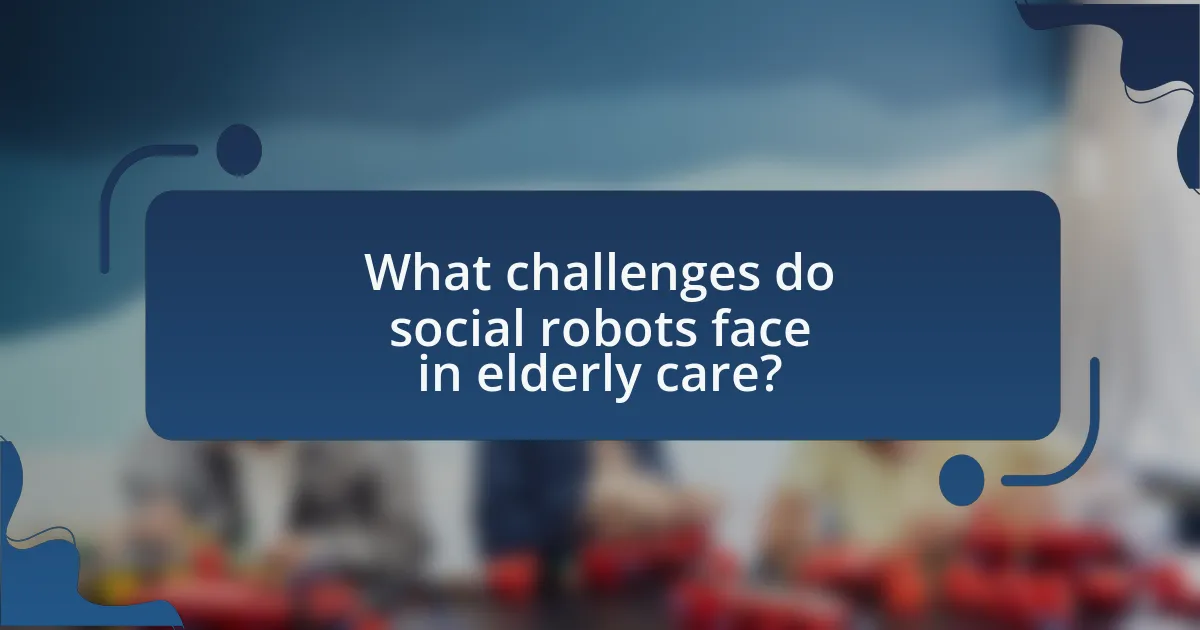
What challenges do social robots face in elderly care?
Social robots face several challenges in elderly care, including technological limitations, user acceptance, and ethical concerns. Technological limitations encompass issues such as inadequate natural language processing capabilities, which hinder effective communication with elderly users. User acceptance is critical, as many elderly individuals may feel uncomfortable or distrustful of robots, impacting their willingness to engage with these technologies. Ethical concerns arise from privacy issues and the potential for dependency on robots, which can affect the quality of human interactions. These challenges must be addressed to enhance the effectiveness of social robots in providing care for the elderly.
What are the ethical considerations surrounding social robots in elderly care?
The ethical considerations surrounding social robots in elderly care include issues of autonomy, privacy, and emotional attachment. Autonomy is compromised when robots make decisions on behalf of elderly individuals, potentially undermining their independence. Privacy concerns arise from the data collection required for robots to function effectively, which may expose sensitive personal information. Additionally, emotional attachment to robots can lead to feelings of loneliness or neglect if human interaction is diminished. Research indicates that while social robots can enhance companionship, they must be designed and implemented with careful attention to these ethical implications to ensure they support rather than replace human relationships.
How do privacy concerns affect the implementation of social robots?
Privacy concerns significantly hinder the implementation of social robots in elderly care by creating barriers to user acceptance and regulatory compliance. These concerns arise from the potential for data breaches, unauthorized surveillance, and misuse of personal information, which can lead to distrust among users and their families. For instance, a study published in the journal “Robotics and Autonomous Systems” highlights that 70% of elderly individuals expressed apprehension about how their personal data would be handled by social robots. This apprehension can result in reluctance to adopt such technologies, ultimately limiting their effectiveness in providing care and companionship. Furthermore, regulatory frameworks, such as the General Data Protection Regulation (GDPR) in Europe, impose strict guidelines on data collection and processing, which can complicate the development and deployment of social robots in healthcare settings.
What are the implications of dependency on social robots for elderly individuals?
Dependency on social robots for elderly individuals can lead to both positive and negative implications. On the positive side, social robots can provide companionship, reduce feelings of loneliness, and assist with daily tasks, thereby enhancing the quality of life for seniors. For instance, studies have shown that interactions with social robots can improve emotional well-being and cognitive function among elderly users. However, excessive reliance on these robots may result in decreased human interaction, potentially leading to social isolation and a decline in interpersonal skills. Furthermore, dependency on technology can create challenges in emergency situations where human intervention is necessary. Research indicates that while social robots can be beneficial, they should complement rather than replace human care to ensure a balanced approach to elderly support.
How do caregivers perceive the use of social robots in elderly care?
Caregivers generally perceive the use of social robots in elderly care as beneficial, viewing them as tools that can enhance the quality of care and improve the well-being of elderly individuals. Research indicates that caregivers appreciate social robots for their ability to provide companionship, assist with daily activities, and monitor health conditions, thereby alleviating some of the burdens on human caregivers. A study published in the journal “Gerontechnology” by authors like K. Wada and H. Shibata found that caregivers reported increased satisfaction and reduced stress levels when social robots were integrated into care routines, highlighting their positive impact on both caregivers and elderly patients.
What are the common concerns caregivers have regarding social robots?
Common concerns caregivers have regarding social robots include issues of reliability, emotional connection, and privacy. Caregivers often worry that social robots may not perform consistently in providing care or companionship, which can lead to a lack of trust in their capabilities. Additionally, caregivers express concerns about the ability of social robots to form genuine emotional connections with elderly individuals, as these relationships are crucial for mental well-being. Privacy issues also arise, as caregivers fear that the data collected by social robots could be misused or inadequately protected, potentially compromising the confidentiality of the elderly individuals they care for.
How can social robots complement the work of human caregivers?
Social robots can complement the work of human caregivers by providing assistance in routine tasks, enhancing social interaction, and monitoring health conditions. These robots can perform activities such as medication reminders, companionship, and basic physical assistance, which allows human caregivers to focus on more complex care needs. Research indicates that social robots can reduce feelings of loneliness and depression among the elderly, as evidenced by a study published in the journal “Gerontology” by authors Sherry Turkle and colleagues, which found that interactions with social robots improved emotional well-being in older adults. Additionally, robots equipped with sensors can monitor vital signs and alert caregivers to potential health issues, thereby improving overall care efficiency and safety.
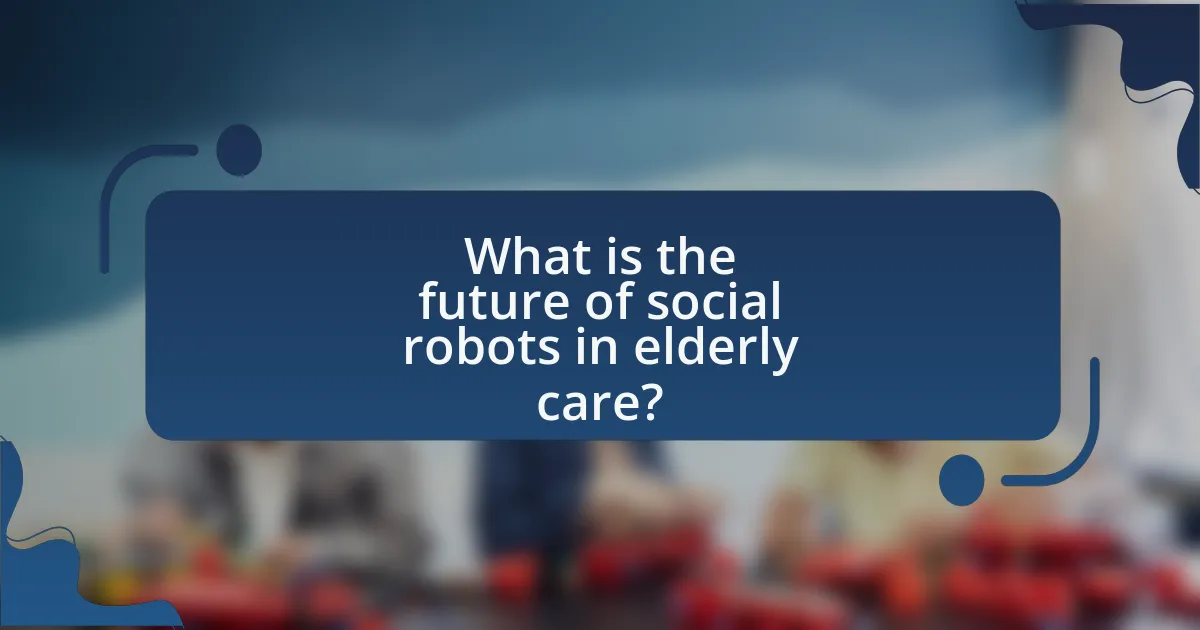
What is the future of social robots in elderly care?
The future of social robots in elderly care is promising, with advancements in artificial intelligence and robotics enhancing their capabilities to provide companionship, assistance, and monitoring. Research indicates that social robots can improve the quality of life for seniors by reducing feelings of loneliness and increasing engagement in daily activities. For instance, a study published in the journal “Gerontechnology” found that robots like PARO, a therapeutic robotic seal, significantly improved emotional well-being among elderly users. Additionally, as the global population ages, the demand for innovative care solutions is expected to rise, leading to increased integration of social robots in healthcare settings.
How is technology evolving to enhance social robots for elderly care?
Technology is evolving to enhance social robots for elderly care through advancements in artificial intelligence, machine learning, and sensor technology. These developments enable robots to better understand and respond to the emotional and physical needs of elderly individuals. For instance, AI algorithms allow robots to recognize speech patterns and emotional cues, facilitating more natural interactions. Additionally, improved sensors enable robots to monitor health metrics, such as heart rate and mobility, providing real-time data to caregivers. Research from the University of Southern California highlights that robots equipped with these technologies can significantly reduce feelings of loneliness among seniors, demonstrating their effectiveness in enhancing quality of life.
What advancements are being made in artificial intelligence for social robots?
Advancements in artificial intelligence for social robots include improved natural language processing, enhanced emotional recognition, and increased autonomy in decision-making. These developments enable social robots to better understand and respond to human emotions, facilitating more meaningful interactions with elderly users. For instance, recent research has shown that AI algorithms can now analyze facial expressions and vocal tones to gauge emotional states, allowing robots to provide tailored companionship and support. Additionally, advancements in machine learning have led to robots that can learn from their interactions, adapting their behavior to meet the specific needs of elderly individuals, thereby improving their overall quality of care.
How might future social robots better meet the needs of the elderly?
Future social robots can better meet the needs of the elderly by incorporating advanced artificial intelligence and machine learning algorithms that enable personalized interactions and support. These technologies allow robots to adapt to individual preferences, monitor health conditions, and provide companionship, which is crucial for reducing feelings of loneliness among seniors. For instance, a study published in the journal “Gerontechnology” found that robots designed with emotional recognition capabilities significantly improved the emotional well-being of elderly users by responding appropriately to their moods. Additionally, integrating telehealth features into social robots can facilitate remote medical consultations, ensuring timely healthcare access for elderly individuals who may have mobility challenges.
What best practices should be followed when integrating social robots into elderly care?
Best practices for integrating social robots into elderly care include ensuring user-centered design, providing adequate training for caregivers, and fostering social interaction. User-centered design focuses on tailoring robots to meet the specific needs and preferences of elderly users, which enhances usability and acceptance. Training for caregivers is essential to ensure they can effectively operate and troubleshoot the robots, thereby maximizing their benefits in care settings. Additionally, promoting social interaction through robots can help reduce feelings of loneliness and isolation among the elderly, as studies have shown that social engagement positively impacts mental health and well-being. For instance, research published in the journal “Gerontechnology” highlights that social robots can significantly improve the quality of life for elderly individuals by facilitating communication and companionship.
How can caregivers be trained to effectively use social robots?
Caregivers can be trained to effectively use social robots through structured training programs that focus on hands-on experience, understanding robot functionalities, and integrating robots into care routines. These programs should include workshops that demonstrate the operational aspects of social robots, allowing caregivers to practice interactions in simulated environments. Research indicates that caregivers who receive comprehensive training report increased confidence and competence in using technology, which enhances the overall quality of care provided to the elderly. For instance, a study published in the Journal of Gerontological Nursing found that caregivers trained in the use of social robots showed a 30% improvement in their ability to engage with elderly patients, leading to better emotional and social outcomes for the residents.
What strategies can be employed to ensure elderly individuals feel comfortable with social robots?
To ensure elderly individuals feel comfortable with social robots, strategies such as personalized interaction, gradual introduction, and user-friendly design can be employed. Personalized interaction involves tailoring the robot’s communication style and responses to match the preferences and needs of the elderly user, which has been shown to enhance engagement and comfort levels. Gradual introduction allows elderly individuals to become familiar with the robot in a low-pressure environment, reducing anxiety and fostering trust over time. User-friendly design focuses on intuitive interfaces and clear functionalities, making it easier for elderly users to operate the robots without frustration. Research indicates that these strategies significantly improve acceptance and comfort, as evidenced by studies showing increased satisfaction and reduced apprehension among elderly users when these approaches are implemented.
